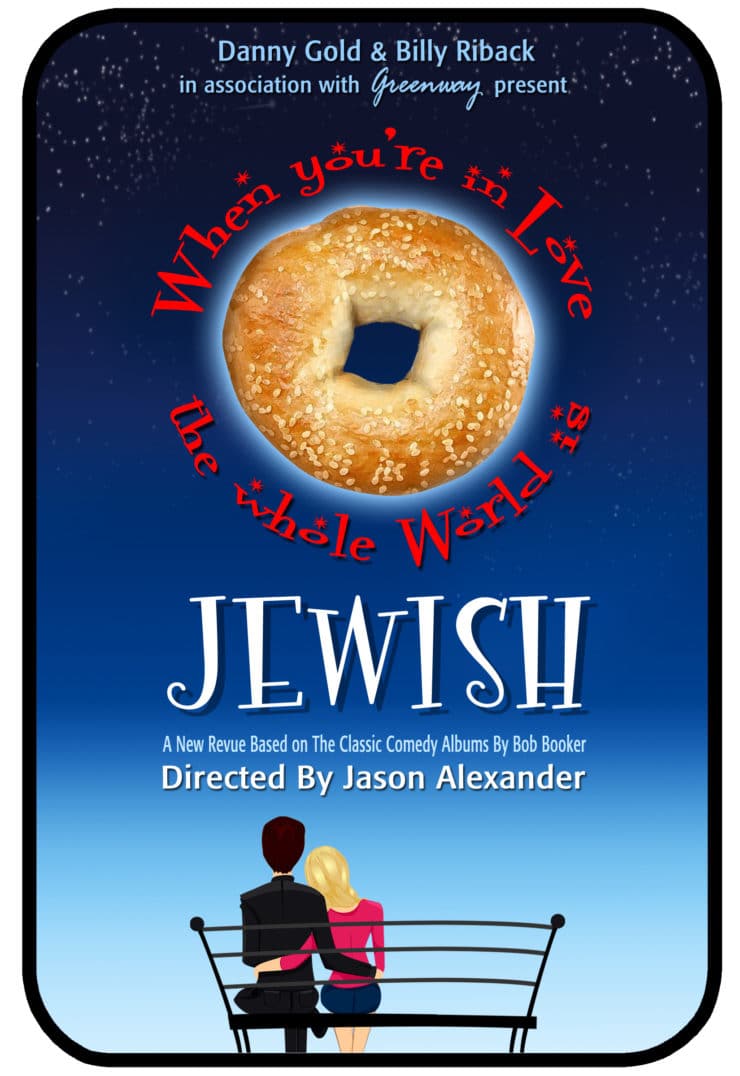
A few weeks ago, I found out that my friend Danny Gold is producing a new stage musical here in the Los Angeles area. The title made me smile: “When You’re in Love, the Whole World is Jewish.” I got really excited when I discovered that Jason Alexander was directing. Of stage and Seinfeld fame, Jason is an Emmy-nominated and Tony-award winning performer. More recently he has focused on plays and musicals, starring in several notable projects including the “The Producers” with Martin Short. He currently serves as the Artistic Director of the Reprise Theatre Company in Los Angeles.
“When You’re in Love, the Whole World is Jewish” is Jason’s most recent theatrical venture. The musical revue is structured as a series of vignettes, loosely connected by a simple plot premise: a Jewish man and a non-Jewish woman fall in love. Guided by a rabbi, the woman is introduced to the magic of Judaism “in 90 minutes,” through several funny sketches and songs. Because I am the “Shiksa in the Kitchen,” and because the show Seinfeld helped to popularize the word “shiksa” by highlighting Elaine’s shiksa-ppeal, I couldn’t help but feel a synergy between this musical and my blog. This fact really hit home when I saw that the show’s poster features the moon as a big bagel in the sky. Yep, I would have to say I am absolutely the target audience for this show!
This musical revue is based on a comedy album released in 1966 called, “When You’re in Love the Whole World is Jewish.” The collection of classic Jewish sketches, jokes and songs was written and produced by Bob Booker & George Foster. The stage show integrates many of the original songs and sketches with some new material, updating some outdated lyrics and inserting funny scenes to round out the story. One of the original 1966 songs, “Would You Believe It,” is clearly a precursor to Adam Sandler’s famous “Hanukkah Song.”
I had the opportunity to interview director Jason Alexander on the phone last week for the Kitchen Memories section of my site. I asked him about the show, an original song he wrote called “Let’s Eat,” and his family food history. Jason was born to a Jewish family in New Jersey. A lot of the dishes he grew up with might be familiar to you, if you have Ashkenazi Jewish ancestry. More on that below.
I saw the show last week (Dennis Prager was a guest star that night!). I had a great time, and I especially loved Jason’s original song, “Let’s Eat.” I would urge you to go and see the show for yourself… alas, the first run sold out very quickly, and an extended run sold out in less 24 hours. Based on the amount of belly laughs in the audience, this musical surely has a bright future and will grow beyond its initial run.
UPDATE: “When You’re in Love, the Whole World is Jewish” has extended its run! See the show’s official website for details.
Meanwhile, enjoy this Kitchen Memories interview with Jason Alexander, along with a recipe inspired by Jason’s childhood—Lokshen mit Kaese, aka Noodles and Cheese.
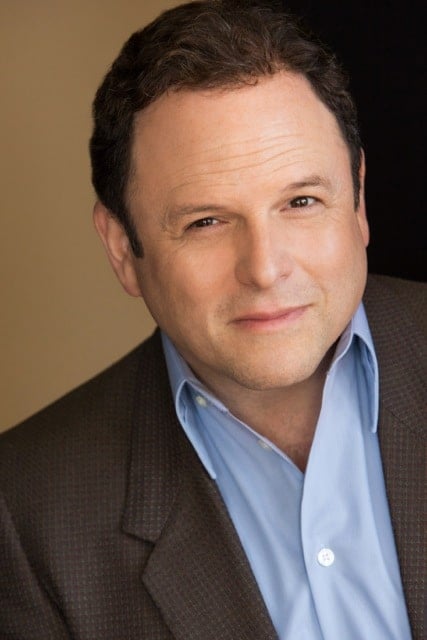
—
Tell me a little about your new show, “When You’re in Love, the Whole World is Jewish.” How’s it going so far?
Well, it seems to be going quite well. The audiences we had this week were really responsive to it. Which was in some ways a bit of a question for us, because the show is a theatricalized version of two old recordings. The original material was written by a guy named Bob Booker and his partner George Foster back in the 60s, in the heyday of sketch comedy albums. Both of these albums had a very Jewish flare to them. The jokes themselves in many ways can be attributed to all kinds of old world ethnicities. The question was, would these sorts of stereotypes from two to three generations back still speak to an audience today? And what we’re finding is that, in fact, they do. That funny is funny is funny. We’re delighted about that. It’s family friendly. There’s nothing sexual, no obscenities. It’s kind of lighthearted and magical in a way that comedy back in that day used to be.
I actually read about these albums. They were pretty popular back in the 1960’s, right?
The albums were very popular back in the day, yeah. They were huge sellers. They were riding the wave, because these were the same producers who produced the first family albums about the Kennedy White House. So all of these albums sort of collectively had a huge following.
I’m told that you actually wrote a new song for the show called “Let’s Eat.” What was the inspiration for that?
Well, the inspiration actually came from the fact that we needed another song. The show is a little over 90 minutes long. Originally there were only four songs, and we thought we needed at least five to balance it out and make it feel like the music is justified. So I thought, “What isn’t represented in the show in general?” And I realized that we hadn’t covered the Jewish holidays. So I started to write a song, a lighthearted look at the big Jewish holidays. And then I got this inspiration that at the end of every one of the holidays, we eat special stuff. So I thought, what if I make it a crazy patter song really about Jewish food, but centered it around the holidays? It is a very, very tricky song to sing because it basically rattles off about 2-dozen Jewish foods very quickly, over and over and over. Each verse is about a holiday. I originally wrote five verses, but we only perform three in the show because it is a very long song. They all end with this crazy recitation of Jewish foods, the last two of which are a “nice piece halvah and a chocolate egg cream,” and every time we’re saying “halvah” we’re throwing halvah out to the audience. The very last verse is performed by our resident “shiksa.” She comes in and talks about her holidays, and how she does exactly what the Jews do, but instead of food she celebrates with alcohol. So she rattles off about 3-dozen different alcoholic beverages.
Are you guys going to record an album?
I have no idea, that cart is way ahead of the horse. Right now there are no plans for anything like that.
So the singing made me think of something I had read about you. I don’t know whether it’s true or not. The article said that you convinced your parents to get you voice lessons so that you could train for your bar mitzvah. Any truth to that?
Um, not quite. I actually got very serious about being in the theater around the time of my bar mitzvah, and I did start voice lessons around the time of my bar mitzvah, but not to make my bar mitzvah sound better.
Can you tell me a little bit about your ancestry?
I have one parent each from Russia and one from Poland on both sides. If you ask me where in Russia and Poland, I would be lost. They’ve often said names that I couldn’t find on a map, so they may be calling it something other than what it actually was.
So you grew up on traditional Ashkenazi food, and you grew up in New Jersey, so I’m guessing you ate a lot of deli food.
There was a lot of deli food, yes!
Did you have a favorite deli?
I grew up in Livingston, New Jersey, and there was only one really great Jewish deli. It was called Eppes Essen.
Are there any delis in Manhattan that you like, or that you still go to?
The standards are the Carnegie and the Stage. I think the Stage may have just closed. Ratners downtown, when I was way downtown. You could never go wrong with several foods in New York… deli certainly, Chinese food, pizza. That was the biggest shock about moving to Los Angeles, Chinese food and pizza went more or less out the window. There are some good Jewish New York-style delis here, though.
Did your mom or dad cook growing up?
My mom actually managed to, which was amazing because she was the primary breadwinner. She was a big muckety muck in the nursing world, and she eventually ran a school of nursing out of the St. Barnabas hospital in Livingston. So she had kind of kooky hours, but she still managed to be the mom who came home and cooked dinner. She was actually a very good cook. A lot of it was not traditional Jewish food, but on holidays certainly the Passover plate was the Passover Plate, and Hanukkah was latkes, and flanken was very big in our house. She made a dish, I can’t remember what she called it, but it was bowtie egg noodles with pot cheese, much moister than the buckwheat. That was one of our favorites. She was a terrific cook. I say was, she’s still alive at 93.
Does she have any of her recipes still? Has she written any of them down for you?
You know they’re probably in a box. Between my mother-in-law, my wife’s grandmother and my mom, we have a boxful of old recipes downstairs. I haven’t cooked in so long that we haven’t looked at them.
Would you say that the noodle and cheese dish was your favorite comfort food as a child?
That was a big one for us. If I call my mother she’ll know exactly what I’m talking about.
I can find a recipe for it. Or maybe you should dig out your recipe box and start cooking some of those old family treasures.
My girlish figure would not do well by it!
—
Jason speaks the truth! Some of those classic Eastern European Jewish recipes are “a minute on the lips, forever on the hips.” That said, they’re fabulously comforting. Here is a simple recipe for the noodle dish he mentioned in the interview. I’ve run across this dish many times over the years, in vintage cookbooks and by submissions from readers. It’s sort of like the Eastern European version of macaroni and cheese. It’s nearly always referred to as Noodles and Cheese, and the basic ingredients are noodles, cheese, butter, salt and pepper. I wasn’t sure of the Yiddish name, so I asked my friend Gil Marks about it. He told me the dish is called Lokshen mit Kaese (“kaese” is pronounced “case”). Sometimes it’s made with pot cheese or farmer’s cheese, other times cottage cheese. I prefer it with Knudsen lowfat cottage cheese, it’s been my favorite since childhood. You can use whichever option you like. This is not a healthy dish by any stretch of the imagination, but it is really comforting. It’s also affordable, and a great way to use up extra cheese before the expiration date (that’s a tip from my friend Shlomit, who also grew up eating this dish). I like mine with lots of black pepper mixed in!
Recommended Products:
We are a participant in the Amazon Services LLC Associates Program, an affiliate advertising program designed to provide a means for us to earn fees by linking to Amazon.com and affiliated sites. As an Amazon Associate I earn from qualifying purchases.
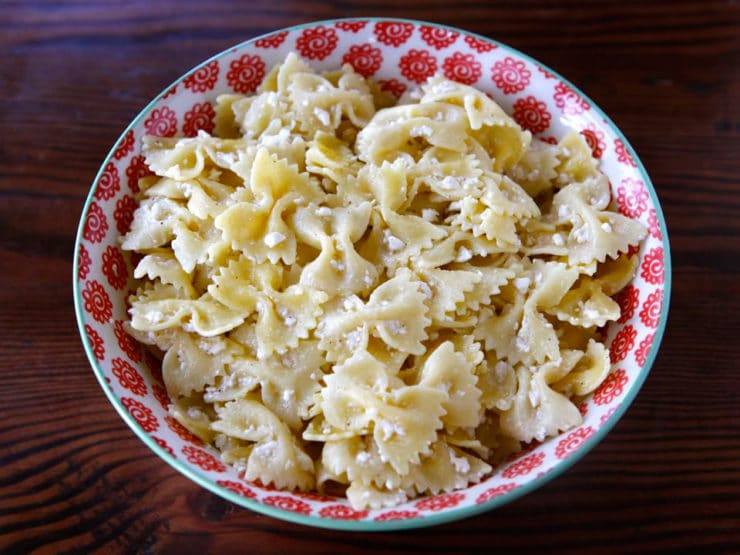
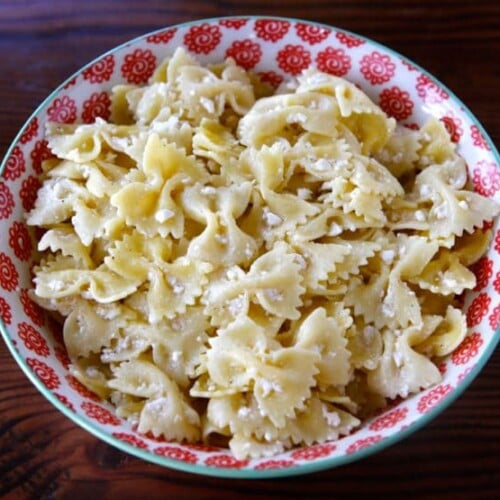
Lokshen mit Kaese - Noodles and Cheese
Ingredients
- 8 ounces bowtie pasta (farfalle), elbow macaroni or egg noodles
- 1/4 cup butter
- Salt and pepper
- 3/4 cup cottage cheese, pot cheese, or farmer’s cheese
Instructions
- Bring 3 quarts of water to a boil. Stir in 1/2 tsp of salt. Add the pasta and cook till tender, but not soft (a little softer than al dente). Drain the pasta in a colander and rinse with cool water.

- Place the empty pot back on the stove. Melt butter in the pot over medium. Add the cooked pasta back to the pot. Stir till the pasta is evenly coated with butter. Some people like to let the pasta “fry” in the butter a bit till it’s lightly browned.

- Remove the buttered pasta from heat. Gently stir in the cheese till evenly mixed. Season with salt and pepper to taste (I use a little less than ½ tsp salt and ¼ tsp pepper).

- Serve hot.

Nutrition

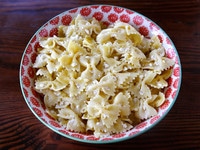
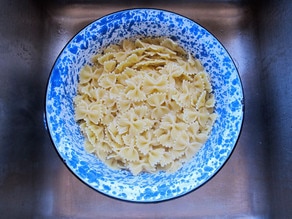
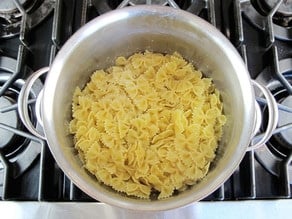
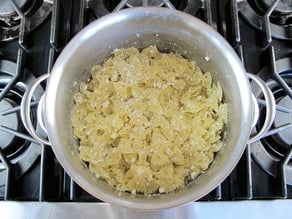
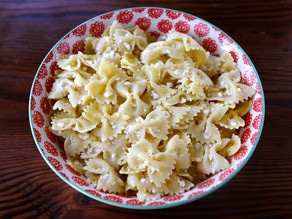


My mom grandma and bubbie have always made this!! We use sour cream instead of butter👍🕎
Best comfort food!
I’ve been eating this and stomach kid. And I’m 54 years old now. My mother, and my grandmother always served it with cinnamon sugar on top instead of salt and pepper. Perfect comfort food. Delicious for breakfast lunch or dinner.
My mother used to make this with either regular cottage cheese or pot-style cottage cheese. She didn’t add butter or margarine to it. She just mixed the hot noodles with the cottage cheese. I used to like it plain like that, the same way I like it today, except I sometimes grind some black pepper on it and occasionally maybe add a little salt, but I find it to be salty enough from the salt in the cottage cheese. My brother liked it sweet with sugar and cinnamon (not my cup of tea). I make it today with Friendship pot-style cottage cheese and extra wide egg noodles. I very occasionally add a little margarine if I’m re-heating a portion, but otherwise I don’t use butter or margarine at all. As a matter of fact, I just made a pot tonight – yum!
My mother always made a sweetened version with cinnamon sugar! Makes me happy just thinking about it. Comfort food for sure!
Love this! I would always have this when I was little and under the weather. It is the perfect comfort food. My mom would make it with egg noodles. I told my husband about it and he thinks I am crazy. His grandma would make some sort of version with pot cheese that he insists cannot be replicated.
I grew up eating this dish as well. It came from the Lithuanian side of my family. Growing up we called it and noodles with pot cheese. But pot cheese is super hard to find these days, so we replace it with farmers cheese now. In our family, It was always made with egg noodles (I think because it made the translucent, thinly sliced onions blend in better) and we grew up eating it sprinkled with cinnamon and sugar rather than Salt and Pepper.
I love this dish,( besides the fact that it tastes) because you can really eat it any time of day. I even love it reheated in the morning for breakfast. It packs a lot of protein in it too which is great. Especially if you can find the pot cheese which I think is higher in protein than the cottage cheese. YUM!!! 😉
Noodles with cottage cheese is my number one childhood comfort food. Both my mother and my grandmother used to make it for me. I really can’t stand cottage cheese…except in this dish! Every time I make it my husband thinks I’m nuts. So glad to know I am not alone.
It’s actually “lokshn mit kez”. Kez is the Yiddish word for cheese. It’s pronounced in Standardized Yiddish & Northeastern (“Lithuanian”) Yiddish “kez” as in the English “he SAYS” with a z sound at the end.
Hi Mikhoyel. The English spelling may be a reflection of a regional pronunciation. I don’t speak Yiddish, but the English spelling of this word was shared with me by my friend Gil Marks (a noted Jewish food historian). It was also verified by a friend of mine named Shlomit who grew up speaking Yiddish. I’m guessing Yiddish pronunciation may vary slightly in different regions, hence the different English spellings.
Add 4 chopped tomatoes, a handful of chopped fresh basil (or a little dried if fresh isnt available), 4 tablespoons of olive oil, kosher salt, black pepper and 3/4 cup of Parmesan cheese to the box of cooked farfalle and you’ve got a tasty meal that’s great served hot or cold!!
Yum!
My mom use to make this for us growing up. The first time I made it for my husband and daughter they weren’t quite sure. My daughter is now 28; she stops by and asks for the dish when she’s not feeling well, even likes it for breakfast. Brought a smile when I saw the recipe!
My husband grew up eating sweetened version of this – just pasta, cottage cheese, and a little sugar (sometimes we add a hint of cinnamon too). Like a simple stovetop lokshen kugel!
Yup, like a simple unbaked lokshen kugel. Thinking I’ll try it sweet next time, thanks for the suggestions! 🙂
Reading this makes me miss a good deli and my old stomping grounds “the bagel belt” East Coast. Lokshen is something my mother would make often, along with kasha varnishkes using the same farfalle. Beyond food, sounds like a visit to L.A. is needed soon to catch the show!
This dish is one of my childhood favorites. I introduced my hubby to the dish. In fact I have been married for over 30 years and when my hubby wants a food-treat he asks for this…and I thought this was a “family food.” Who knew?
I ate this dish when I was a child too. It also can be served on a sweeter side – omitting pepper and sprinkling sugar on top when served. Kids love it this way.
I totally grew up eating this! Now my 16-year-old still eats it once a week, at least. I make it with a lot less butter, though!
OMG! I grew up eating that, too! Hubby and kidlet do NOT have the same appreciation for it! :p